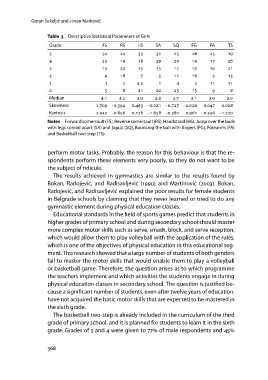Page 368 - Istenič Andreja, Gačnik Mateja, Horvat Barbara, Kukanja Gabrijelčič Mojca, Kiswarday Vanja Riccarda, Lebeničnik Maja, Mezgec Maja, Volk Marina. Ur. 2023. Vzgoja in izobraževanje med preteklostjo in prihodnostjo. Koper: Založba Univerze na Primorskem
P. 368
an Šekeljić and Jovan Marković
Table 3 Descriptive Statistical Parameters of Girls
Grade FS RS HS SA SQ FG FA TS
.
Median
Skewness . . . . . . . .
Kurtosis . –. . –. –. –. . .
. –. . –. –. . –. –.
Notes Forward somersault (FS), Reverse somersault (RS), Handstand (HS), Jump over the buck
with legs spread apart (SA) and Squat (SQ), Bouncing the ball with fingers (FG), Forearms (FA)
and Basketball two-step (TS).
perform motor tasks. Probably, the reason for this behaviour is that the re-
spondents perform these elements very poorly, so they do not want to be
the subject of ridicule.
The results achieved in gymnastics are similar to the results found by
Bokan, Radojević, and Radisavljević (1990) and Martinović (2003). Bokan,
Radojević, and Radisavljević explained the poor results for female students
in Belgrade schools by claiming that they never learned or tried to do any
gymnastic element during physical education classes.
Educational standards in the field of sports games predict that students in
higher grades of primary school and during secondary school should master
more complex motor skills such as serve, smash, block, and serve reception,
which would allow them to play volleyball with the application of the rules,
which is one of the objectives of physical education in this educational seg-
ment. This research showed that a large number of students of both genders
fail to master the motor skills that would enable them to play a volleyball
or basketball game. Therefore, the question arises as to which programme
the teachers implement and which activities the students engage in during
physical education classes in secondary school. The question is justified be-
cause a significant number of students, even after twelve years of education,
have not acquired the basic motor skills that are expected to be mastered in
the sixth grade.
The basketball two-step is already included in the curriculum of the third
grade of primary school, and it is planned for students to learn it in the sixth
grade. Grades of 5 and 4 were given to 77 of male respondents and 45
368
Table 3 Descriptive Statistical Parameters of Girls
Grade FS RS HS SA SQ FG FA TS
.
Median
Skewness . . . . . . . .
Kurtosis . –. . –. –. –. . .
. –. . –. –. . –. –.
Notes Forward somersault (FS), Reverse somersault (RS), Handstand (HS), Jump over the buck
with legs spread apart (SA) and Squat (SQ), Bouncing the ball with fingers (FG), Forearms (FA)
and Basketball two-step (TS).
perform motor tasks. Probably, the reason for this behaviour is that the re-
spondents perform these elements very poorly, so they do not want to be
the subject of ridicule.
The results achieved in gymnastics are similar to the results found by
Bokan, Radojević, and Radisavljević (1990) and Martinović (2003). Bokan,
Radojević, and Radisavljević explained the poor results for female students
in Belgrade schools by claiming that they never learned or tried to do any
gymnastic element during physical education classes.
Educational standards in the field of sports games predict that students in
higher grades of primary school and during secondary school should master
more complex motor skills such as serve, smash, block, and serve reception,
which would allow them to play volleyball with the application of the rules,
which is one of the objectives of physical education in this educational seg-
ment. This research showed that a large number of students of both genders
fail to master the motor skills that would enable them to play a volleyball
or basketball game. Therefore, the question arises as to which programme
the teachers implement and which activities the students engage in during
physical education classes in secondary school. The question is justified be-
cause a significant number of students, even after twelve years of education,
have not acquired the basic motor skills that are expected to be mastered in
the sixth grade.
The basketball two-step is already included in the curriculum of the third
grade of primary school, and it is planned for students to learn it in the sixth
grade. Grades of 5 and 4 were given to 77 of male respondents and 45
368


